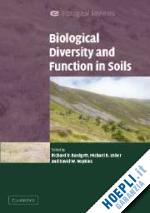List of contributors; Preface; Acknowledgements; Part I. Introduction: 1. Developing new perspectives from advances in soil biodiversity research Diana H. Wall, Alastair H. Fitter and Eldor A. Paul; Part II. The Soil Environment: 2. The habitat of soil microbes Iain M. Young and Karl Ritz; 3. Twenty years of molecular analysis of bacterial communities in soils and what have we learned about function? A. G. O'Donnell, S. R. Colvan, E. Malosso and S. Supaphol; 4. Carbon as a substrate for soil organisms D. W. Hopkins and E. G. Gregorich; Part III. Patterns and Drivers of Soil Biodiversity: 5. The use of model Pseudomonas fluorescens populations to study the causes and consequences of microbial diversity Paul B. Rainey, Michael Brockhurst, Angus Buckling, David J. Hodgson and Rees Kassen; 6. Patterns and determinants of soil biological diversity Richard D. Bardgett, Gregor W. Yeates and Jonathan M. Anderson; 7. How plant communities influence decomposer communities David A. Wardle; 8. The balance between productivity and food web structure in soil ecosystems Peter C. Ruiter, Anje-Margriet Neutel and John Moore; 9. Rhizosphere carbon flow: a driver of soil microbial diversity? D. B. Standing, J. I. Rangel Castro, J. I. Prosser, A. Meharg and K. Killham; Part IV. Consequences of Soil Biodiversity: 10. Microbial community composition and soil nitrogen cycling: is there really a connection? Joshua P. Schimel, Jennifer Bennett and Noah Fierer; 11. Biodiversity of saprotrophic fungi in relation to their function: do fungi obey the rules? Clare H. Robinson, E. Janie Pryce Miller and Lewis J. Deacon; 12. Is diversity of mycorrhizal fungi important for ecosystem functioning? J. R. Leake, D. Johnson, D. P. Donnelly, L. Boddy and D. J. Read; 13. Trophic structure and functional redundancy in soil communities Heikki Setälä, Matty P. Berg and T. Hefin Jones; 14. Plant-soil feedback and soil biodiversity affect the composition of plant communities Wim H. van der Putten; 15. Response of the soil bacterial community to perturbation Alan J. McCarthy, Neil D. Gray, Thomas P. Curtis and Ian M. Head; Part V. Applications of Soil Biodiversity: 16. Soil biodiversity in rapidly changing tropical landscapes: scaling down and scaling up Ken E. Giller, David Bignell, Patrick Lavelle, Mike Swift, Edmundo Barrios, Fatima Moreira, Meine van Noordwijk, Isabelle Barios, Nancy Karanja and Jeroen Huising; 17. Restoration ecology and the role of soil biodiversity J. A. Harris, P. Grogan and R. J. Hobbs; 18. Soil biodiversity: stress and change in grasslands under restoration succession Lijbert Brussaard, Ron G. M. de Goede, Lia Hemerik and Bart C. Verschoor; 19. Soil biodiversity, nature conservation and sustainability Michael B. Usher; Part IV. Conclusion: 20. Underview: origins and consequences of below-ground biodiversity Karl Ritz; Index.












